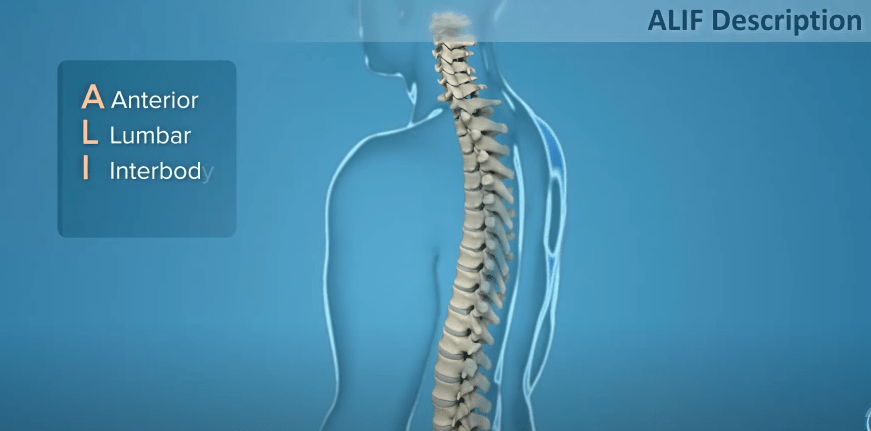Anterior Lumbar Interbody Fusion, or ALIF surgery, is quickly changing the face of spine care by offering patients a way to reduce recovery time and complications while also potentially relieving chronic back pain. Instead of using the conventional back approach, surgeons can enter the spine from the front through the abdomen in a very effective procedure. This change is remarkably comparable to how less invasive techniques, such as laparoscopic surgeries, have transformed other healthcare domains. Because ALIF fuses the lumbar vertebrae to stabilize the spine and relieve pressure on the spinal nerves, it is especially helpful for people with degenerative disc disease, spondylolisthesis, and spinal instability.
This cutting-edge method is becoming a more popular option for spine surgery since it offers patients a number of noteworthy benefits. The ALIF technique is remarkably successful in lowering the risk of complications that are frequently connected to conventional surgeries. Recovery is significantly accelerated by reducing the damage to muscles and nerves, enabling patients to resume their regular activities in a matter of weeks as opposed to months. Many people experience long-term relief from the anterior approach, which also makes it possible for improved spinal alignment and disc height restoration. This is particularly true for those who suffer from excruciating leg and back pain brought on by nerve compression. With patients reporting less pain, more mobility, and a quicker return to daily life, ALIF surgery’s influence on spine health is evident as it continues to gain popularity.
ALIF Surgery Bio Data and Professional Information
| Procedure Name | ALIF (Anterior Lumbar Interbody Fusion) |
|---|---|
| Conditions Treated | Degenerative disc disease, spondylolisthesis, spinal instability |
| Access Approach | Through the front of the abdomen (anterior approach) |
| Main Benefits | Faster recovery, minimal muscle disruption, improved spinal alignment |
| Recovery Time | 6-12 weeks, full recovery possible |
| Risks Involved | Infection, nerve damage, vascular complications |
| Recommended For | Patients with lumbar spine issues, nerve compression |
| Website for Reference | Cleveland Clinic – ALIF Surgery |
The ALIF procedure represented a paradigm shift in the management of lower back pain, even though spinal fusion surgeries have been carried out for decades. In addition to providing a straightforward method of treating spinal problems, the anterior approach circumvents the significant disruptions to muscles and nerves that come with conventional back surgeries. As a result, severe spinal conditions can be effectively treated with a minimally invasive procedure.

ALIF is unique in that it can address a variety of spine problems. For example, it works especially well to treat degenerative disc disease, a condition in which the discs between the vertebrae start to degrade and cause instability. ALIF helps to stabilize the spine and lessen pain from nerve compression by fusing the damaged vertebrae. ALIF may be essential for reestablishing alignment and releasing pressure in situations such as spondylolisthesis, in which one vertebra slides out of position. Given its adaptability, it’s no surprise that more patients are using ALIF as a long-term solution, especially those with chronic back problems.
The impact ALIF surgery is having on the field of spine health is demonstrated by its rising popularity among athletes and celebrities. In fact, because of its minimal recovery time and relatively quick recovery, the procedure has drawn interest from people with physically demanding jobs. Celebrities are using ALIF to treat chronic back pain, which is frequently made worse by the physical demands of their jobs. ALIF is incredibly adaptable and has changed the game for people who need to resume their careers without having to deal with a drawn-out recuperation period.
Additionally, the procedure has wider ramifications for trends in healthcare. It supports the industry’s continuous drive for less invasive procedures. The effectiveness of these treatments increases with technology, providing patients with better results in addition to speedier recoveries. Over time, the surgical methods used in ALIF have improved, and new developments like titanium cages and sophisticated bone grafts have raised success rates and decreased the likelihood of complications. Now that they can execute this delicate procedure more precisely, surgeons can produce faster and more predictable results.
ALIF surgery has advantages that go beyond mere recuperation. Patients can return to their regular lives sooner thanks to the substantial reduction in risks associated with traditional back surgeries, which improves their quality of life overall. Long-term stability is another benefit of vertebral fusion, which stops the spine from further degenerating. ALIF is a potential long-term solution for spine health since it can lessen the need for additional surgeries.
In addition to offering outstanding outcomes for patients with spinal problems, ALIF is revolutionizing the practice of spinal surgery thanks to developments in surgical technology. It is anticipated that ALIF will continue to advance as more patients choose it to treat their persistent back pain, with even more sophisticated methods and equipment being created. With ALIF setting the standard for a safer, more efficient treatment option for patients in need of relief, the future of spine surgery appears to be incredibly bright.
